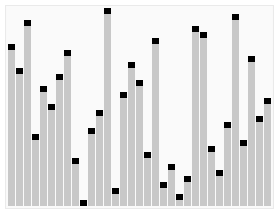 A run of heapsort sorting an array of randomly permuted values. In the first stage of the algorithm the array elements are reordered to satisfy the heap property. Before the actual sorting takes place, the heap tree structure is shown briefly for illustration. | |
| Class | Sorting algorithm |
|---|---|
| Data structure | Array |
| Worst-case performance | |
| Best-case performance | (distinct keys)[1][2] or (equal keys) |
| Average performance | |
| Worst-case space complexity | total auxiliary |
In computer science, heapsort is a comparison-based sorting algorithm which can be thought of as "an implementation of selection sort using the right data structure."[3] Like selection sort, heapsort divides its input into a sorted and an unsorted region, and it iteratively shrinks the unsorted region by extracting the largest element from it and inserting it into the sorted region. Unlike selection sort, heapsort does not waste time with a linear-time scan of the unsorted region; rather, heap sort maintains the unsorted region in a heap data structure to efficiently find the largest element in each step.
Although somewhat slower in practice on most machines than a well-implemented quicksort, it has the advantages of very simple implementation and a more favorable worst-case O(n log n) runtime. Most real-world quicksort variants include an implementation of heapsort as a fallback should they detect that quicksort is becoming degenerate. Heapsort is an in-place algorithm, but it is not a stable sort.
Heapsort was invented by J. W. J. Williams in 1964.[4] The paper also introduced the binary heap as a useful data structure in its own right.[5] In the same year, Robert W. Floyd published an improved version that could sort an array in-place, continuing his earlier research into the treesort algorithm.[5]
- ^ Bollobás, B.; Fenner, T. I.; Frieze, A. M. (1996). "On the Best Case of Heapsort" (PDF). Journal of Algorithms. 20 (11): 205–217. doi:10.1006/jagm.1996.0011.
- ^ Sedgewick, Robert; Schaffer, Russel W. (October 1990). The Best Case of Heapsort (Technical report). Princeton University. TR-293-90.
- ^ Skiena, Steven (2008). "Searching and Sorting". The Algorithm Design Manual (3rd ed.). Springer. p. 116. doi:10.1007/978-3-030-54256-6_4. ISBN 978-3-030-54255-9.
The name typically given to this algorithm, heapsort, obscures the fact that the algorithm is nothing but an implementation of selection sort using the right data structure.
- ^ Williams 1964
- ^ a b Brass, Peter (2008). Advanced Data Structures. Cambridge University Press. p. 209. ISBN 978-0-521-88037-4.


